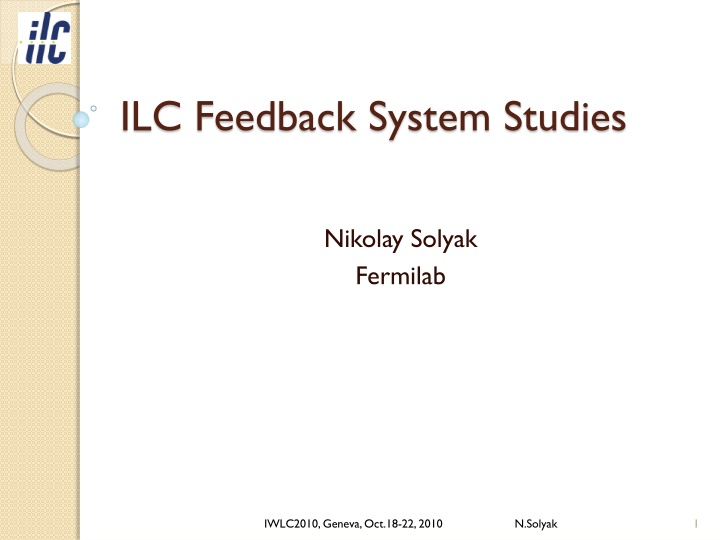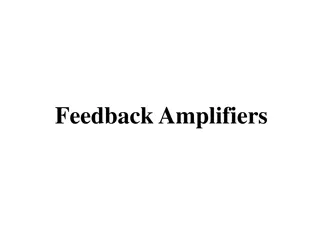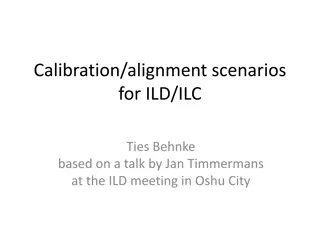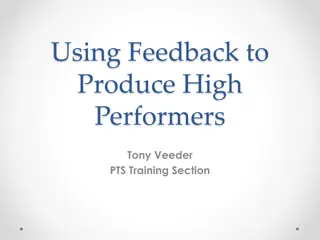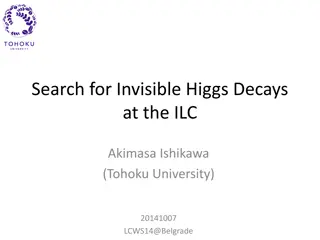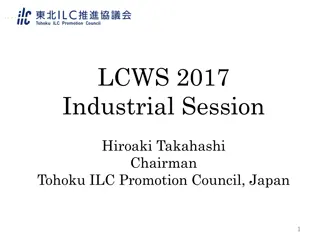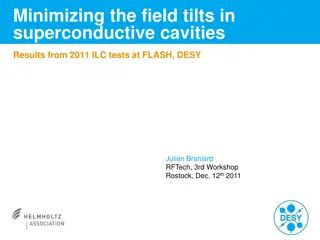ILC Feedback System Studies
Delve into the realm of advanced feedback control systems used in particle accelerators, exploring cascaded feedback control, adaptive alignment feedback control, and multi-cascaded feedback control. Discover the intricacies of feedback calculations, including algorithms and matrices, and how they drive the dynamics of accelerator models. Uncover the significance of fast feedback systems and their impact on beam transport accuracy. Learn about the evolution of feedback systems for linear colliders, highlighting their crucial role in maintaining desired beam parameters over extended periods.
Download Presentation

Please find below an Image/Link to download the presentation.
The content on the website is provided AS IS for your information and personal use only. It may not be sold, licensed, or shared on other websites without obtaining consent from the author.If you encounter any issues during the download, it is possible that the publisher has removed the file from their server.
You are allowed to download the files provided on this website for personal or commercial use, subject to the condition that they are used lawfully. All files are the property of their respective owners.
The content on the website is provided AS IS for your information and personal use only. It may not be sold, licensed, or shared on other websites without obtaining consent from the author.
E N D
Presentation Transcript
ILC Feedback System Studies Nikolay Solyak Fermilab IWLC2010, Geneva, Oct.18-22, 2010 N.Solyak 1
Outline Cascaded feedback control Adaptive Alignment feedback control Conclusions and plans IWLC2010, Geneva, Oct.18-22, 2010 N.Solyak 2
Multi-Cascaded Feedback control Proposed and realized at SLAC for SLC linac at 1990th Generalized Fast Feedback System in the SLC, L. Hendrickson et.al., SLAC-PUB-5683 (Nov.1991) NLC Feedback studies (~2000-2004) ILC feedback studies 2006 -2008 IWLC2010, Geneva, Oct.18-22, 2010 N.Solyak 3
FEEDBACK CALCULATIONS The feedback algorithm can be summarized equations which are based on the predictor-corrector formalism of digital control theory. Est. values of states, associated with FB loop, based on the previous state, actuator settings, and meas. Calc. actuator settings based on the estim. state vector = + + x u x K L(y Nr H x ) = u + k 1 k k ~ + x + + 1 1 k k k xkestimate of the state vector on the kth pulse. - system matrix and describes the dynamics of the accelerator model. - control input matrix. It describes how changes in the actuators should affect the state. u - actuator vector. It contains the current actuator settings with reference values subtracted. L - Kalman filter matrix. Given an error on the estimate of the sensor readings, it applies a correction term to the estimate of the state vector. y - measurement vector. It contains the current meas. with reference values subtracted. H - output matrix. It maps the state vector to the output vector. That is, given an estimate of the states, it gives an estimate of what the sensors should read. K - gain matrix. It is derived in a manner similar to L. It is designed to minimize the RMS of selected state vector elements. N- controller-reference-input matrix. It maps the reference vector to actuator settings and is directly derivable from the model of the accelerator. r - reference vector which contains setpoints for the states controlled by the loop. IWLC2010, Geneva, Oct.18-22, 2010 N.Solyak 4
Cascaded Fast Feedback in NLC In the NLC multi-cascade scheme, each feedback receives information from all of the upstream loops. The beam transport is an overconstrained least squares fit matrix, which converts many upstream states to the fitted downstream location. The simulations used 30 minutes of ATL-like GM with a coefficient of 5.0e-7 m2/m/sec, a typical value for the SLAC site. The BPM resolution was 0.1 m and results from 100 random seeds were averaged. Beam-based Feedback Simulations for the NLC Linac*, (Sept.2000) L. Hendrickson, N. Phinney, P. Raimondi, T. Raubenheimer, A. Seryi, P. Tenenbaum IWLC2010, Geneva, Oct.18-22, 2010 N.Solyak 5
NLC studies (cont.) A set of 9 FB loops are sufficient to maintain the desired emittance for several hours. After ~ 8hrs, even with the FB loops unacceptable emittance dilution is observed. Feedback Systems for Linear Colliders, L. Hendrickson et al. PAC99 Evolution of the emittance at the end of the NLC main linac under the influence GM ( ATL coeff = 5.10 7m2/m/sec) Developments in beam-based Alignment and Steering of the NLC Main Linac, SLAC-Pub 8933, 2001 P. Tenenbaum, L. Hendrickson, T.O. Raubenheimer IWLC2010, Geneva, Oct.18-22, 2010 N.Solyak 6
Ground motion models The integrated absolute GM spectra (solid lines) and the integrated relative motion of 2 objects separated by 50 m distance (dashed lines). IWLC2010, Geneva, Oct.18-22, 200 7 N.Solyak
ISSUES OF STABILITY AND GROUND MOTION IN ILC A. Seryi, L.Hendrickson, G. White, SLAC (SLAC-PUB-11661, Jan. 2006) Assumptions: Integrated simulations of ILC, from linac entry to the IP were set up with 5Hz feedback and idealized IP feedback. GM models: B, C and K ML: 5 distributed 5Hz FB loops in (each with 4X and 4Y dipole corr. and 8 BPMs) were cascaded and have exp. response of 36 pulses. In BDS there was one loop, with 9 BPMs and 9 dipole correctors. The IP deflection (X&Y) in 5Hz loop was not cascaded and has 6 pulse exponential response. Additional component jitter of up to 25 nm in BDS and 50 nm in ML. DR: extraction jitter 10% of beam sigma. The beam current jitter 5%. RF jitter: 0.5%,2 uncorr. ampl./phase on each klystron; 0.5 corr. phase The BPM resolution was assumed to be 100 nm. Beam jitter at the end of ML 50% of beam size Summary of ILC stability goals: 1. ML: Up to gm C with additional component jitter 30nm 2. BDS: Up to gm C/3 (or B*3 ) and component jitter 10nm 3. GM and component jitter contribute to lumi degradation equally IWLC2010, Geneva, Oct.18-22, 2010 N.Solyak 8
FNAL activity in cascaded FB studies In 2008 Linda Hendrickson algorithms was implemented and used with Lucretia code. Continue SLAC ILC studies for ML and RTML. Studies of FB efficiency vs. number of model parameters Gain parameter Frequency response BPM resolution GM models V.Ivanov, N.Solyak ML like lattice layout: 5 FB loops of 2 correctors, 8 BPMs in each plane IWLC2010, Geneva, Oct.18-22, 2010 N.Solyak 9
Effect of BPM resolution Dynamics of vertical emittance for BPM resolution 1 m (left) and 5 m (right) Ground motion model B IWLC2010, Geneva, Oct.18-22, 2010 N.Solyak 10
Efficiency of Feedback control Pulse #. The effect of FB control for entire initially aligned linac . Period of simulation T=10 hours. Control signals applied to the correctors with an interval of 100 s. IWLC2010, Geneva, Oct.18-22, 2010 N.Solyak 11
Adaptive Alignment (AA) Basic Principle Proposed by V. Balakin (1991) for VLEPP project local method: BPM readings (Ai) of only 3 (or more) neighboring quads are used to determine the shifting of the central quad ( yi). + = + E 1 ( ( 2 ( i a )) y cnvg a a K L 1 1 i i i i 2 E i cnvg : Convergence parameter (< 0.3) ai : BPM reading Ki : Quad strength L : Distance between successive quads E : Energy gain between successive quads E : Beam Energy at central quad The procedure is iteratively repeated New position of quad & BPM: new i y y = old i y i More general case: K B i = s s - quad length 1 i 4 IWLC2010, Geneva, Oct.18-22, 2010 N.Solyak 12
AA test at SLAC, 1996 Experimental Test of the Adaptive Alignment of the Magnetic Elements of Linear Collider, V.Balakin et. al; Linac 1996. IWLC2010, Geneva, Oct.18-22, 2010 N.Solyak 13
ILC ML parameters, initial misalignments: Bunch length = 300 m; Norm. vertical emittance = 20 nm; Norm. horizontal emittance = 800 nm; ML budget for vert. emittance = 8 nm; FODO lattice: = 75 /60 in x/y plane. Quad oset = 300 m; Quad rotation = 300 rad; BPM oset = 300 m; BPM resolution = 1 m; Cavity oset = 300 m; Cavity pitch = 300 rad; Cryostat oset = 200 m; Cryostat pitch = 20 rad. IWLC2010, Geneva, Oct.18-22, 2010 N.Solyak 14
Example of AA, no GM All the quads in ILC lattice are misaligned randomly by 100 um RMS in an otherwise perfect linac. AA procedure smoothes out the beam thrusts, and decreases the emittance growth significantly from ~12000nm to ~20nm (initial). Gain=0.2 Sensitive to BPM-Q offset and BPM resolution IWLC2010, Geneva, Oct.18-22, 2010 N.Solyak 15
Effect of GM in perfectly aligned linac GM model C . (a) Normalized vertical emittance vs. time in a perfectly aligned linac. AA of 100 iterations and 0.3 convergence factor is implemented after every one hour of GM model C . (b) A blown-up portion of the plot after Adaptive Alignment. AA is implemented after intervals of 1 hour after GM. IWLC2010, Geneva, Oct.18-22, 2010 N.Solyak 16
AA with GM after static alignment (1-2-1, DFS and bumps) b) a) Zoom After GM (no AA) AA every 1hr after GM (a) Normalized vertical projected emittance vs. time in a dispersion-free steered linac. AA is implemented after every hour of GM model C . (b) A blown-up portion of the red plot after 100 AA iterations, gain=0.3. Orbit after DFS is used as a reference, in this case AA is not sensitive to BMP-to-Quad offsets IWLC2010, Geneva, Oct.18-22, 2010 N.Solyak 17
Effect of BPM resolution Normalized vertical emittance as a function of time in a dispersion-free steered linac. AA of 100 iterations and 0.3 convergence factor is implemented after every one hour of ground motion of model C for (a) BPM resolution of 0.2 m and (b) for BPM resolution of 1 m. As shown in studies the effective BPM resolution can be significantly reduced by averaging over a few bunches (all bunches in train) IWLC2010, Geneva, Oct.18-22, 2010 N.Solyak 18
Effect of tuning intervals In a real machine the Adaptive Alignment feedback control is working pulse by pulse (5Hz). In each pulse the information from all N previous pulses is used for calculation of correction. In simulation we are using correction ones per time interval (~0.5 hrs for ~1 month of dynamis with GM) IWLC2010, Geneva, Oct.18-22, 2010 N.Solyak 19
Effect of N of iterations IWLC2010, Geneva, Oct.18-22, 2010 N.Solyak 20
AA FB control for one month of GM. Y norm. emitt. at the ML exit after 100 AA iterations for GM models A, B, C. Total period one month, time step 2 hrs. Y-norm. emittance. nm Average of 10 GM seeds for each model . Convergence (gain) = 0.2; Individual GM seeds for model B. IWLC2010, Geneva, Oct.18-22, 2010 N.Solyak 21
Summary of AA studies In the absence of dynamic steering the Ground In the absence of dynamic steering the Ground Motion and jitter can severely limit machine Motion and jitter can severely limit machine performance ( performance (emittance emittance dilution); dilution); Adaptive Alignment algorithm can be helpful as a Adaptive Alignment algorithm can be helpful as a dynamic tuning technique to stabilize the dynamic tuning technique to stabilize the emittance performance in statically Steered performance in statically Steered linac time scale (site dependant). time scale (site dependant). emittance for ~months linac for ~months We expect to implement this algorithm every few We expect to implement this algorithm every few pulses; however, a time interval of more than half pulses; however, a time interval of more than half hour between iterations can cause significant growth hour between iterations can cause significant growth in in emittance emittance, particularly in GM model C . , particularly in GM model C . IWLC2010, Geneva, Oct.18-22, 2010 N.Solyak 22
Plans for future studies Dynamics studies in ILC linac was slowed down due to luck of people. Plan to continue this studies in 2011 Open Post-doc and Associated scientist position at Fermilab (ILC and Project X beam dynamics studies). ILC-CLIC collaboration is essential. IWLC2010, Geneva, Oct.18-22, 2010 N.Solyak 23
